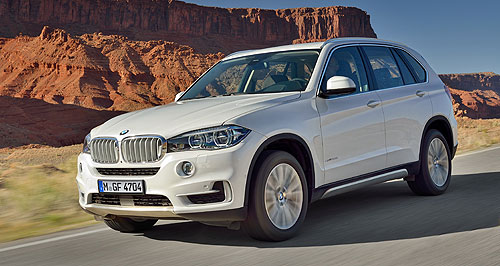Future models - BMW - X5BMW goes rear-drive with third-gen X5X marks the spot: The third-generation BMW X5 maintains a similar shape to the current model, but features more aggressive styling. More powerful, fuel-efficient X5 revealed with two new variants added to line-up30 May 2013 A LARGER, more powerful BMW X5 could join the two-wheel-drive brigade when the new-generation SUV lands in Australia late this year. The German car-maker has officially unveiled its new SUV hero, revealing a pair of new entry-level variants to the line-up – the xDrive25d and rear-drive sDrive25d. BMW Group Australia general manager of corporate communications Lenore Fletcher said that the upsurge in sales of two-wheel-drive SUVs was undeniable, but would not confirm an Australian berth for the sDrive model. “It’s too early for us to discuss whether or not we would be including that in the Australian line-up, but certainly I think that across the board it is something that is considered by all makers,” Ms Fletcher said. Only three variants will be available in Europe at launch, which is likely to be just after September’s Frankfurt motor show -- the diesel-engined xDrive30d and M50d M Performance, and the petrol-engined xDrive50i – with others arriving in European showrooms from December. Ms Fletcher said it was too early to comment on Australian specifications and pricing, but that the local arm of the German brand was keen to remain competitive. “If you look at X5 in the Australian market place, we are the number one prestige SUV and we are very conscious of that positioning with the vehicle. “You can be very confident that the pricing and specifications of the vehicle will be such that they will ensure we retain that position,” she said. The third generation of BMW’s wildly successful X5 maintains the same basic shape of the outgoing model but incorporates the company’s current design language that already features on recent model such as the 3 Series. Growing in size over the current model, the 2013 X5 is 35mm longer and 56mm wider, but 2mm shorter, while the wheelbase remains unchanged. The front-end styling is more aggressive than then before with larger kidney grilles and wider headlights that stretch from just above the front wheel arch to the very edge of the grille. BMW’s familiar twin-circle headlights are now tapered at the top and bottom and the bumper features an X-like design with L-shaped air intakes under the fog-lights. A sharp crease runs from the headlights along the length of the vehicle to the new three-dimensional LED tail-lights. The rear of the vehicle features a two-section automatic tailgate and appears to have a more squared-off look than the current model. The cargo area has increased by 30 litres to 650 litres with the seats up, and 1870 litres with the seats down, up by 120 litres. The cabin features redesigned driver and front passenger seats, and the availability of heated rear seats for the third row, while the clean dash design remains faithful to the current generation of BMW models. A large 10.25-inch screen linked to BMW’s iDrive system dominates the centre stack, and features in-car Facebook and Twitter functions, as well as a ConnectDrive Office that allows the driver to dictate emails while driving. BMW says the X5’s engines are either heavily revised or ‘new generation’ powerplants with more power, better fuel economy and fewer carbon dioxide emissions than before. The 4.4-litre petrol V8 in the xDrive50i is 10 per cent more powerful than the current model, pumping out 330kW, while fuel use is down by 16 per cent to 10.4 litres per 100km on the European cycle. In the diesel range, the 3.0-litre straight six under the redesigned bonnet of the xDrive30d gets a 10kW boost of power to 190kW, while torque is up 20Nm to 560Nm. Fuel use is cut by 1.2 litres to 6.2L/100km on the combined cycle, while emissions are down by 31g/km to 162g/km. The M50d adds a second turbocharger to the 3.0-litre diesel engine but maintains the outgoing model’s figures of 280kW/740Nm. Fuel use is down by 0.1L/100km to 6.7L/100 while the 0-100km/h sprint is 0.1 seconds quicker at 5.3 seconds. The third-generation X5 will continue to be built in the US alongside the X1, X3 and upcoming X4 SUVs.  Read more4th of February 2013  BMW X5All future models Alfa Romeo Alfa Romeo Abarth Abarth Audi Audi Aston Martin Aston Martin BMW BMW Bentley Bentley Chrysler Chrysler Chevrolet Chevrolet Dodge Dodge Citroen Citroen Ferrari Ferrari DS DS Ford Ford Fiat Fiat FPV FPV Foton Foton Haval Haval Great Wall Great Wall Honda Honda Holden Holden Hyundai Hyundai HSV HSV Isuzu Isuzu Infiniti Infiniti Jeep Jeep Jaguar Jaguar Lamborghini Lamborghini Kia Kia Lexus Lexus Land Rover Land Rover Mazda Mazda Maserati Maserati Mercedes-Benz Mercedes-Benz McLaren McLaren Mini Mini Nissan Nissan Mitsubishi Mitsubishi Peugeot Peugeot Opel Opel Proton Proton Porsche Porsche Renault Renault Ram Ram Saab Saab Rolls-Royce Rolls-Royce Smart Smart Skoda Skoda Subaru Subaru SsangYong SsangYong Tesla Tesla Suzuki Suzuki Toyota Toyota Volvo VolvoX5 pricing
Motor industry news |
Click to shareBMW modelsAll future models Alfa Romeo Alfa Romeo Abarth Abarth Audi Audi Aston Martin Aston Martin BMW BMW Bentley Bentley Chrysler Chrysler Chevrolet Chevrolet Dodge Dodge Citroen Citroen Ferrari Ferrari DS DS Ford Ford Fiat Fiat FPV FPV Foton Foton Haval Haval Great Wall Great Wall Honda Honda Holden Holden Hyundai Hyundai HSV HSV Isuzu Isuzu Infiniti Infiniti Jeep Jeep Jaguar Jaguar Lamborghini Lamborghini Kia Kia Lexus Lexus Land Rover Land Rover Mazda Mazda Maserati Maserati Mercedes-Benz Mercedes-Benz McLaren McLaren Mini Mini Nissan Nissan Mitsubishi Mitsubishi Peugeot Peugeot Opel Opel Proton Proton Porsche Porsche Renault Renault Ram Ram Saab Saab Rolls-Royce Rolls-Royce Smart Smart Skoda Skoda Subaru Subaru SsangYong SsangYong Tesla Tesla Suzuki Suzuki Toyota Toyota Volvo VolvoX5 pricing
Motor industry news |


















































Facebook Twitter Instagram